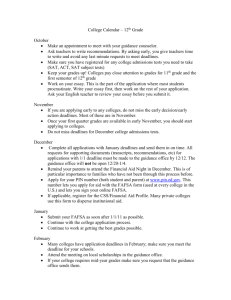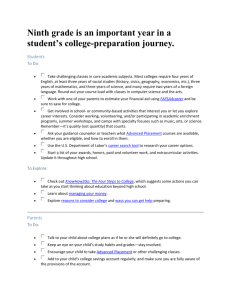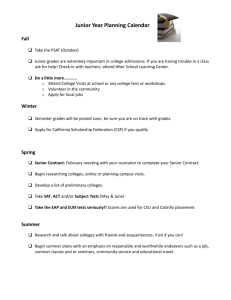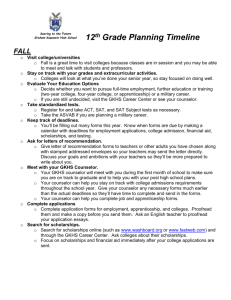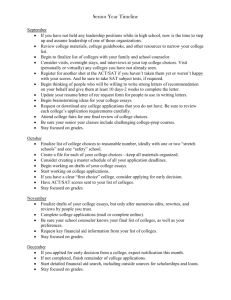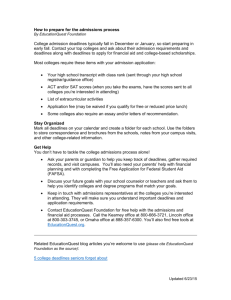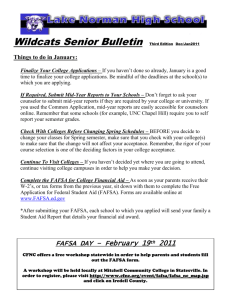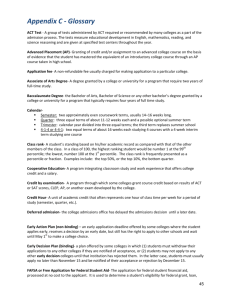12th Grade
advertisement
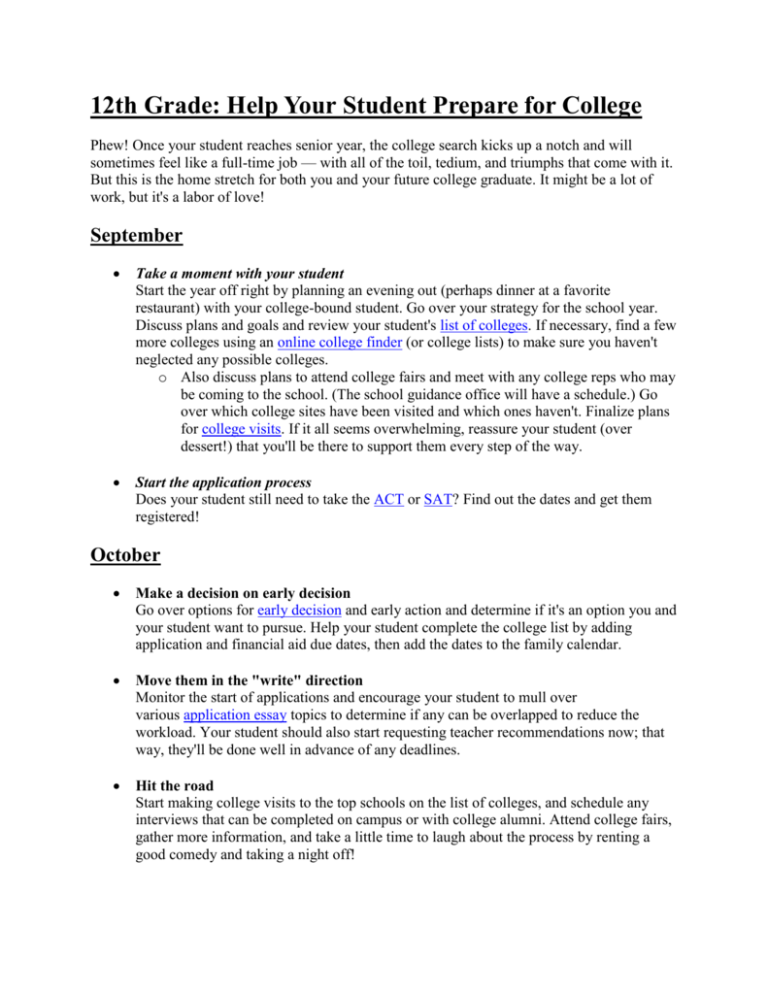
12th Grade: Help Your Student Prepare for College Phew! Once your student reaches senior year, the college search kicks up a notch and will sometimes feel like a full-time job — with all of the toil, tedium, and triumphs that come with it. But this is the home stretch for both you and your future college graduate. It might be a lot of work, but it's a labor of love! September Take a moment with your student Start the year off right by planning an evening out (perhaps dinner at a favorite restaurant) with your college-bound student. Go over your strategy for the school year. Discuss plans and goals and review your student's list of colleges. If necessary, find a few more colleges using an online college finder (or college lists) to make sure you haven't neglected any possible colleges. o Also discuss plans to attend college fairs and meet with any college reps who may be coming to the school. (The school guidance office will have a schedule.) Go over which college sites have been visited and which ones haven't. Finalize plans for college visits. If it all seems overwhelming, reassure your student (over dessert!) that you'll be there to support them every step of the way. Start the application process Does your student still need to take the ACT or SAT? Find out the dates and get them registered! October Make a decision on early decision Go over options for early decision and early action and determine if it's an option you and your student want to pursue. Help your student complete the college list by adding application and financial aid due dates, then add the dates to the family calendar. Move them in the "write" direction Monitor the start of applications and encourage your student to mull over various application essay topics to determine if any can be overlapped to reduce the workload. Your student should also start requesting teacher recommendations now; that way, they'll be done well in advance of any deadlines. Hit the road Start making college visits to the top schools on the list of colleges, and schedule any interviews that can be completed on campus or with college alumni. Attend college fairs, gather more information, and take a little time to laugh about the process by renting a good comedy and taking a night off! Think dollars and cents Certain colleges require a supplemental financial aid form, known as the CSS/PROFILE. This has an earlier deadline than the FAFSA. Check the schools to which your student is applying to find out if you'll need to complete this form in addition to the FAFSA. November Nag (but just a little) You might have to start nagging your teen about early application deadlines, if applicable. Narrow your college list to those schools to which applications will be sent. Try to use time over the Thanksgiving break to get in a campus visit. As your student starts working on (or completing) applications, offer to proofread and provide constructive criticism. December Start coordinating paperwork If your student plans to have another go at the SAT or ACT, make sure they register. The January sitting (February for ACT) is their absolute last chance. Keep an eye on the calendar Get your federal financial aid forms (FAFSA) from the guidance office or the Web and attend workshops if there any available. Leave gentle reminders about any January or February application deadlines and have your student confirm that teachers and guidance staff are up-to-date with reference forms. Also make sure that transcripts are being sent to all short-list colleges. Celebrate early Usher in the New Year with a family toast to the future, whatever it may bring. January Remember "parent" deadlines If you have everything you need, file your income taxes and begin filling out financial aid forms, such as the FAFSA. Finish and mail these forms as soon as possible — and never late! Keep in mind that many schools list earlier FAFSA filing dates than that which is listed on the form itself. Finish up applications Encourage your student to complete all of his or her applications, even those with later deadlines. Make copies of everything and save them! If SATs are being taken this month, find out if "rush" scores are required for any of your student's choice schools. When the last application hits the mailbox, CELEBRATE! February Follow up Unless confirmations have arrived, your student should consult colleges by phone or online to check the status of applications. They should keep track of who they speak with and find out if there are any materials that still need to be sent in. March Work through the waiting game After nearly four years, the wait is nearly over! There may be some decision letters arriving this month and, hopefully, they will bring great news. April Stay cool Resist the urge to open letters addressed to your student. Also, don't despair when thin envelopes show up — that doesn't always mean it's a rejection letter. Some schools send out enrollment forms later. Remain supportive If your student is accepted, cheer and applaud! If a rejection letter arrives, try to put things in perspective with a comment like "It's an extremely competitive college and your math test scores must have hurt." (Don't say something like "The admission folks at that school seemed like a bunch of Bozos from the get-go." Even if that's what you think!) Take a second look Compare financial aid offers and contact financial aid offices with any questions. If you feel you need to, appeal the awards. Plan crunch-time visits to campuses, as needed, to help with the big decision: which school to attend. Follow up Was your student placed on a waitlist? Make sure to return any waitlist cards and follow up with the admission offices regularly. Send updated records and other information, if available. Encourage your student to write an upbeat "Please take me, and this is why you should" letter. It may make a difference. Take a deep breath If you and your student have made a final decision about which school to attend, then congratulations! Now, make sure you send in any required deposit. Be sure not to dawdle and miss the May 1 deadline or your student may lose their spot to some other hopeful student. Last but not least, notify the schools that weren't chosen that your student won't be attending, particularly if an aid offer was made. May Polish off the details Make sure your student takes any needed AP exams. Remember P's and Q's Encourage your student to write a thank you note to anyone who may have been especially helpful in the college-planning process. Guidance counselors are often unsung heroes, as are teachers who write recommendations, scholarship agencies, admission counselors, financial aid officers, secretaries, tours guides, or other students. Of course this isn't obligatory, but recipients are sure to be pleasantly surprised. Buy some extra-long sheets Stay on top of housing plans in case there are any forms that need to be returned. You and your student may also consider alternatives to the dorms, if there are any. Find out the dates for freshman orientation, as some schools have them in spring or summer. And of course, make sure your student knows when course registration is. June Play the waiting game You and your student may both be a little jumpy around mail-delivery time each day. Keep your eye out for "the envelope," but also keep your cool. Give your student (and yourself!) a pat on the back Help your student organize a file to keep track of summer mailings from the college. Categories might include orientation, housing, course registration, and finances. Attend to the details Your student may want to consider summer courses to accelerate or place out of required courses, but make sure the college has confirmed that it will accept the credits. Also have your student confirm that the high school has forwarded a final transcript to the college. Ready...set...go! On a less stressful note, take your student shopping for supplies and dorm décor. Don't forget about suitcases for packing clothes! Give yourself some well-deserved credit After everything is done, sit down and have a good cry while you go back over all the masterpieces your student has created over the years. And remember, this is a good thing and you've done a GREAT JOB!
